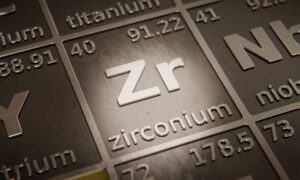Technology of magnesium thermal production of sponge zirconium from zirconium dioxide

According to the most conservative estimates, by the middle of the 21st century, energy consumption on the planet will double. This will be a consequence of the development of the global economy, population growth and other geopolitical and economic factors.
Therefore, nuclear energy currently occupies a leading position in the world and is not going to give it up yet.
The growth of energy capacity will lead to an increase in the need for nuclear fuel and its components.
Zirconium alloys are the main material for the cladding of fuel elements of nuclear power reactors. The use of zirconium for this purpose is primarily due to the main physical characteristic of the structural material of the active zones – a low neutron capture coefficient.
APPLICATION
- Nuclear power engineering (manufacture of fuel elements)
- Pyrotechnics
- Manufacture of alloys
- Manufacture of superconductors
- Electrovacuum technology
- Manufacture of insulators in high-frequency equipment
- Ceramics
- Enamels
- Refractors
- Medicine
PROJECTS
JSC ” Titanium Institute” has developed a modern, highly efficient technology for producing sponge zirconium from zirconium dioxide by chlorination and magnesium-thermal reduction of the resulting zirconium tetrachloride.
The basic process flow chart for magnesium-thermal production of sponge zirconium includes the following process operations:
– salt chlorination of zirconium dioxide;
– purification of the resulting zirconium tetrachloride;
– vacuum separation of the zirconium-containing reaction mass;
– preparation of magnesium-reducing agent;
– processing of sponge zirconium blocks into commercial products.
A pilot plant for producing sponge zirconium was designed and recommendations for the design of the pilot equipment were developed.
Experimental batches of sponge zirconium were produced at pilot plants, which, based on the content of the main impurities and physical and chemical properties, can be used as a basis for the production of Zr1Nb alloy for nuclear power engineering.
TECHNOLOGY ADVANCES
- The development of special technological methods makes it possible to extract metal zirconium (zirconium sponge) necessary for the further production of zirconium alloys, which are used in the prepared fuel for nuclear reactors.
- The technology received a high rating from experts.
- It is determined by optimal technical and economic indicators.
- The pre-production plant has a standard module for the production of spongy zirconium. Increasing the productivity of industrial production can be achieved by increasing the number of standard module units to the required number.
Get a free consultation and presentation of our technologies!
Fill out the form and our experts will contact you to discuss the details, answer your questions, and offer the best solutions for your business. In the “Message text” field, briefly write what you are interested in.